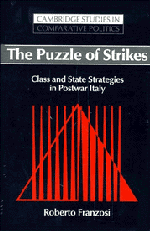Book contents
- Frontmatter
- Contents
- List of tables, figures, and equations
- Dedication
- Preface
- Acknowledgments
- 1 The puzzle box
- 2 Labor-market conditions and bargaining power
- 3 When do workers strike? How the economy matters
- 4 Organizational resources and collective action
- 5 The structure of collective bargaining
- 6 Class power, politics, and conflict
- 7 Mobilization processes: the 1969 autunno caldo
- 8 Countermobilization processes: reactions by the state and employers to strike waves
- 9 The picture in the puzzle
- Epilogue
- Appendix: the data
- Notes
- Bibliography
- Index
2 - Labor-market conditions and bargaining power
Published online by Cambridge University Press: 08 January 2010
- Frontmatter
- Contents
- List of tables, figures, and equations
- Dedication
- Preface
- Acknowledgments
- 1 The puzzle box
- 2 Labor-market conditions and bargaining power
- 3 When do workers strike? How the economy matters
- 4 Organizational resources and collective action
- 5 The structure of collective bargaining
- 6 Class power, politics, and conflict
- 7 Mobilization processes: the 1969 autunno caldo
- 8 Countermobilization processes: reactions by the state and employers to strike waves
- 9 The picture in the puzzle
- Epilogue
- Appendix: the data
- Notes
- Bibliography
- Index
Summary
How do the fluctuations in economic activity affect the number of strikes? Obviously, through their effect on unemployment. When this goes down, when the working day gets longer in the factories, due to new orders, when workers are employed six or seven days a week, instead of four or five, they realize (without having to consult the statistics) that business is going well and they try to take advantage of the situation. Hence, strikes. When, on the contrary, unemployment soars, when workers see some of their fellow workers being dismissed, and the number of working hours and days curtailed, they hesitate to strike, at least over wage issues, for fear of being replaced by the army of the unemployed. The curve of strikes dwindles. Therefore, there is a relationship of cause and effect between the fluctuations of unemployment and those of strikes.
Rist (1907, p. 402)HOW THE LABOR-MARKET ARGUMENT RUNS
Labor-market theories of strikes claim that union behavior and the propensity to strike are heavily dependent on the state of the labor market. As early as the beginning of the twentieth century, in two seminal articles, Rist (1907, 1912) argued that there exists a strong relationship between the business cycle and strike activity, but that this relationship is mainly indirect, mediated by the state of the labor market. According to Rist (1912, pp. 748–9), “the rise or fall of strikes is related to the fluctuations of unemployment, because it is through the rise or fall of unemployment that industrial hardship or prosperity is felt by the workers.”
- Type
- Chapter
- Information
- The Puzzle of StrikesClass and State Strategies in Postwar Italy, pp. 30 - 55Publisher: Cambridge University PressPrint publication year: 1995

